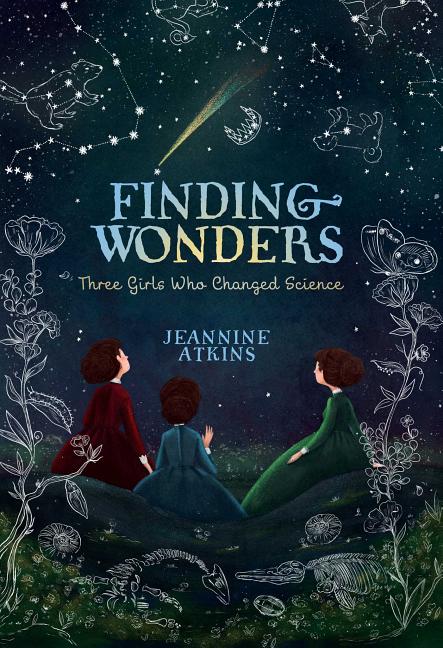Book Descriptions
for Finding Wonders by Jeannine Atkins
From Cooperative Children's Book Center (CCBC)
Three girls coming of age in three separate centuries, all facing limits on expectations and opportunities because of being female, and all making significant contributions to science. Their stories unfold in three verse narratives. “The Artist’s Daughter” introduces Maria Sibylla Merian (1647–1717), who grew up loving nature, butterflies in particular. She was the first to observe, understand, and document the life cycle of moths and butterflies. Mary Anning (1799–1847) was “The Carpenter’s Daughter.” She found and helped unearth what turned out the be the first ichthyosaur fossil. “The Mapmaker’s Daughter,” Maria Mitchell (1818–1889), grew up in a Quaker family on Nantucket. She could repair a sextant as well as her father, and when the king of Denmark announced a prize for the first person to discover a new comet, Mary eventually won, after six years of closely, doggedly observing the skies. Personalities of the three come alive in fictionalized profiles full of small, meaningful details as they move from childhood to adulthood. An author’s note and suggestions for further reading are included. (Ages 10–13)
CCBC Choices 2017. © Cooperative Children's Book Center, Univ. of Wisconsin - Madison, 2017. Used with permission.
From the Publisher
A gorgeously written novel in verse about three girls in three different time periods who grew up to become groundbreaking scientists.
Maria Merian was sure that caterpillars were not wicked things born from mud, as most people of her time believed. Through careful observation she discovered the truth about metamorphosis and documented her findings in gorgeous paintings of the life cycles of insects.
More than a century later, Mary Anning helped her father collect stone sea creatures from the cliffs in southwest England. To him they were merely a source of income, but to Mary they held a stronger fascination. Intrepid and patient, she eventually discovered fossils that would change people’s vision of the past.
Across the ocean, Maria Mitchell helped her mapmaker father in the whaling village of Nantucket. At night they explored the starry sky through his telescope. Maria longed to discover a new comet—and after years of studying the night sky, she finally did.
Told in vibrant, evocative poems, this stunning novel celebrates the joy of discovery and finding wonder in the world around us.
Maria Merian was sure that caterpillars were not wicked things born from mud, as most people of her time believed. Through careful observation she discovered the truth about metamorphosis and documented her findings in gorgeous paintings of the life cycles of insects.
More than a century later, Mary Anning helped her father collect stone sea creatures from the cliffs in southwest England. To him they were merely a source of income, but to Mary they held a stronger fascination. Intrepid and patient, she eventually discovered fossils that would change people’s vision of the past.
Across the ocean, Maria Mitchell helped her mapmaker father in the whaling village of Nantucket. At night they explored the starry sky through his telescope. Maria longed to discover a new comet—and after years of studying the night sky, she finally did.
Told in vibrant, evocative poems, this stunning novel celebrates the joy of discovery and finding wonder in the world around us.
Publisher description retrieved from Google Books.


